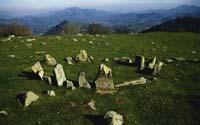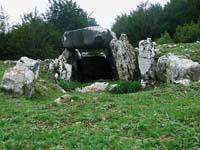Xabier Peñalver:

The truth is that I have not researched only chromlechs, it is part of an investigation that we started about 25 years ago. At that time we started the research project of the remains of the Final Bronze and the Iron Age, since we barely knew about that time. Then I studied several orchards of Moors and part of my doctoral thesis refers to them.
But I didn't just do that, among other things, to investigate walled villages. For example, in the village of Intxur, located between Toulouse and Albiztur, I spent nine years doing excavations and that work paid off. And we show that the people here were as developed as others in Europe, against what was previously thought.
Yes, about the last millennium BC. But the nomads do not explain how the inhabitants of the villages bury their dead, since around the villages there are no nomads, all are around the Pyrenees.
Earlier, some proposed that the shepherds of the peoples went to the Pyrenees in summer, where they buried the dead in the nomads. But this hypothesis is incredible. If not, what did they do with those who died in summer around the town? They would not have two types of burials, except in the event of the death of one or the other. In addition, the shepherds of Intxur would probably go in summer to Aralar, not to the Pyrenees. And in Aralar there is no cromlech.
I believe that the people of the villages buried the dead in lands near the town, in cysts or in stone drawers, as in other peoples of the continent. For example, they were found in the excavation of La Hoya in Rioja Alavesa (Laguardia).

That is. We have researched 1,104 Moorish orchards, all of them in the surroundings of the Pyrenees. To the east they reach Andorra, where there is the limit on the river Leitzaran, from where to the west there are only a few. I think the limitation to the Pyrenees is very significant.
Of course, what today is the border between the two states was not then the border. On the north and south slopes are the cromlechs. They are located in grazing areas, in strategic places, such as hills, hills of mountains and an average height of 1.109 meters. Keep in mind that at that point you could not live all year.
On the other hand, although in most cases they are isolated, in some places there are sets of several cromlech. The most abundant complex is that of Okabe, in Baja Navarra, where the whole of Ilarrita is located, with twenty-six orchards of Moors.
Yes, they are fairly homogeneous. Most have been excavated by archaeologist Jacques Blot and some have been dated by 14 carbon techniques. The oldest 1.313-1.004 and the most recent 354-12. In this sense, it should be noted that no evolution has been noticed, that is, over time they maintained the same model.
These are stone circles, usually 5-6 meters in diameter, small and large. The smallest is called Middle of the Zotales and is 1.2 meters in diameter, while the largest is located on the Collado de Azpegi and is 21 meters in diameter. Both are in Navarre.
The stones delimiting the diameter are sometimes large slabs that are placed vertically in the ground. On other occasions they are smaller stones, placed on top of each other like a small wall. Sometimes they form concentric circles or are formed by large vertical stones... In addition, some cromlech have a tumulus, a top of earth.

In the center the ashes of the deceased are preserved. They are inside a stone structure that is not the same. We have divided the centers into eight types. There are clues or stone paintings, including circles, or U-shaped structures. In one of them the ashes are found inside a container, in another in a bucket dug in rock, under a pile of stones...
The truth is that not much is known about the remains we have found. We know that in every dwelling garden the ashes of one person were buried, and by the bones and teeth that are not well burned among the ashes it seems that they were all men and adults, but we are not sure.
It seems that they did not keep all the ashes of the burned body, but only one or two squads. Therefore, it may be more appropriate to call these funerary monuments cenotaphs than tombs. And it does not seem that the objective was to keep the traces of the deceased, but to keep them symbolically.
Otherwise, in many places and times, along with the corpse the goods were buried. Cromlechs, however
we have just found it, we do not know if it is because they had few goods, or they had no habit of doing it or no signs have remained.

And not little! We want to know more about the Moors' orchards, but above all, we want to find the places of residence of those who made them. And in the walled villages, that is, in the case of knowing where the living beings lived, we want to clarify where they buried the dead.
On the other hand, in my opinion, the work to unravel the mystery of the nomads should not be done only by archaeologists, as are linguists. In fact, being west to Leitzaran could be related to the separation of basins and bardulians. And it is that that of the nomads coincides with the border between these two peoples. This limitation also distinguishes two dialects from Basque. I think we can know something more by pulling that thread.
I have an anecdote. I was on the mountain, studying a garden of Moors and the civil guards stopped me. At that time, they especially cared for the Pyrenees and found it very suspicious that it was a guy like me. I explained what I did and they let me escape, but after making it clear that they did not want to see more on the mountain taking the compass and the map.
In this sense, it is significant that the ashes of an ancestor are distributed in Spain and France. In fact, in the center of a cromlech was placed one of those mojones that define the border and that, of course, did not without wanting.

Buletina
Bidali zure helbide elektronikoa eta jaso asteroko buletina zure sarrera-ontzian











